
On March 18, 1925, one of the deadliest tornado outbreaks in recorded history generated at least twelve significant tornadoes and spanned a large portion of the midwestern and southern United States. In all, at least 751 people were killed and more than 2,298 were injured, making the outbreak the deadliest tornado outbreak, March 18 the deadliest tornado day, and 1925 the deadliest tornado year in U.S. history. The outbreak generated several destructive tornadoes in Missouri, Illinois, and Indiana on the same day, as well as significant tornadoes in Alabama and Kansas. In addition to confirmed tornadoes, there were undoubtedly others with lesser impacts, the occurrences of which have been lost to history.
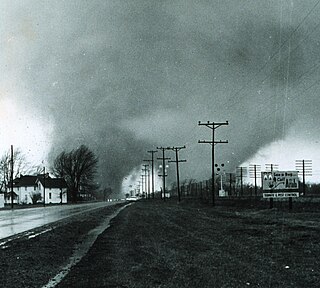
On April 10–12, 1965, a historic severe weather event affected the Midwestern and Southeastern United States. The tornado outbreak produced 55 confirmed tornadoes in one day and 16 hours. The worst part of the outbreak occurred during the afternoon hours of April 11 into the overnight hours going into April 12. The second-largest tornado outbreak on record at the time, this deadly series of tornadoes, which became known as the 1965 Palm Sunday tornado outbreak, inflicted a swath of destruction from Cedar County, Iowa, to Cuyahoga County, Ohio, and a swath 450 miles long (724 km) from Kent County, Michigan, to Montgomery County, Indiana. The main part of the outbreak lasted 16 hours and 35 minutes and is among the most intense outbreaks, in terms of tornado strength, ever recorded, including at least four "double/twin funnel" tornadoes. In all, the outbreak killed 266 people, injured 3,662 others, and caused $1.217 billion in damage.

From April 9–11, 1947, a significant tornado outbreak produced catastrophic effects over portions of the southern Great Plains, in the contiguous United States. The outbreak generated at least 12, and possibly 17 or more, tornadoes, many of which were significant. On Wednesday, April 9, a series of related tornadoes spawned by a single supercell, dubbed the Glazier–Higgins–Woodward tornadoes, swept through the U.S. states of Texas, Oklahoma, and Kansas. Most of the damage and all the deaths are still blamed on one large tornado, known as the Glazier–Higgins–Woodward tornado, that traveled 98 mi (158 km) from Texas to Oklahoma, beginning over the South Plains. This event, up to nearly 2 mi (3.2 km) in width, was often compared to the Tri-State tornado, because it was originally thought to have left a 198-to-221-mile-long path, was similarly large and intense for much of its path, and was also retroactively rated F5 on the modern-day Fujita scale, but it is now believed to have been part of a 125-to-170-mile-long family of nine or 10 tornadoes.

The 1985 United States–Canada tornado outbreak, referred to as the Barrie tornado outbreak in Canada, was a major tornado outbreak that occurred in Ohio, Pennsylvania, New York, and Ontario, on May 31, 1985. In all 44 tornadoes were counted including 14 in Ontario, Canada. It is the largest and most intense tornado outbreak ever to hit this region, and the worst tornado outbreak in Pennsylvania history in terms of deaths and destruction.
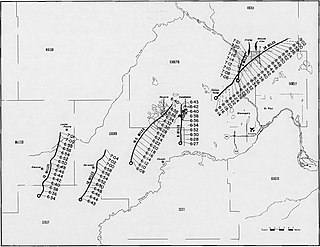
On May 5–8, 1965, a significant tornado outbreak affected much of the Central United States. For four consecutive days, tornado outbreaks produced at least three significant (F2+) tornadoes each day, and at least two violent (F4–F5) tornadoes on three of the four days. The entire sequence generated 37 significant tornadoes, including at least nine violent tornadoes, one of which was rated F5. On May 5, two F4s struck Iowa, including a long-tracked tornado family that injured 11 people. On May 6, an outbreak of six strong tornadoes, four of them violent F4s, affected Minneapolis and St. Paul, Minnesota, and has been nicknamed "The Longest Night", killing 13 people and causing major damages—at the time the most damaging single weather event in Minnesota history. Three of the six tornadoes occurred on the ground simultaneously, and two of them hit the section of Minnesota State Highway 100 and University Avenue in the city of Fridley. Both Fridley tornadoes damaged 1,100 homes and destroyed about 425; total losses reached $14.5 million, $5 million of which was to the Fridley school system.

From April 2–3, 1956, a large, deadly tornado outbreak affected the Great Plains, parts of the South, and the upper Midwest in the contiguous United States, especially the Great Lakes region. The outbreak produced at least 55 tornadoes, including an F5 that devastated the Grand Rapids metropolitan area in the U.S. state of Michigan on April 3. It was one of three tornadoes to move across southwest Lower Michigan on that day. A fourth tornado struck north of the Manistee area, in the northern part of the peninsula. The Hudsonville–Standale tornado killed 18 and injured 333. It remains the fourth deadliest tornado on record in Michigan and is the most recent F5 on record there. Several other deadly, intense, long-tracked tornadoes also occurred during the outbreak. In addition to the fatalities in Kansas, Oklahoma, Michigan and Berlin, Wisconsin, three people were killed in Tennessee, one person in Kentucky and two more people in Wisconsin. In total, 39 were killed during the entire event.
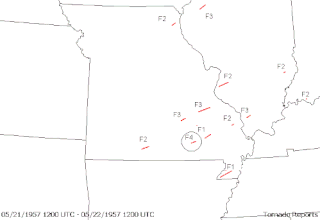
The May 1957 Central Plains tornado outbreak sequence was a tornado outbreak sequence that took place across the US Central Plains from May 19 to May 21, 1957. The most destructive tornado of the outbreak was rated at F5, the highest level, and is often called the Ruskin Heights tornado. The worst of the damage occurred in Ruskin Heights, a suburb and housing development south of Kansas City, Missouri. A total of 57 tornadoes were reported from Colorado to the Mississippi Valley and 59 people were killed during the outbreak, including 44 in the Ruskin Heights tornado.
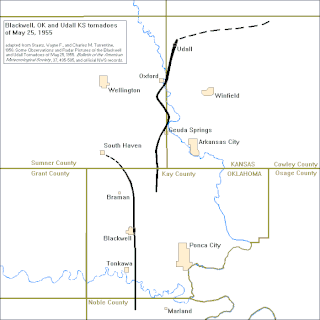
The 1955 Great Plains tornado outbreak was a deadly tornado outbreak that struck the southern and central U.S Great Plains States on May 25–26, 1955. It produced at least 47 tornadoes across seven states including two F5 tornadoes in Blackwell, Oklahoma, and Udall, Kansas that caused most of the casualties. The outbreak killed 102 people while injuring hundreds more. Unusual electromagnetic activity was observed, including St. Elmo's fire.
On February 19–20, 1884, one of the largest and most widespread tornado outbreaks in American history occurred over the Southeastern United States, known as the Enigma tornado outbreak due to the uncertain number of total tornadoes and fatalities. Nonetheless, an inspection of newspaper reports and governmental studies published in the aftermath reveals successive, long-tracked tornado families striking Alabama, Georgia, Illinois, Indiana, Kentucky, Mississippi, North Carolina, South Carolina, Tennessee and Virginia, with an estimation of at least 51—and possibly 60 or more—tornadoes.
The 1956 McDonald Chapel tornado was a deadly weather event that took place during the afternoon of April 15, 1956, across the Greater Birmingham area in Jefferson County, Alabama, with damage most severe in McDonald Chapel. The F4 tornado killed 25 people and injured 200 others. While only two known tornadoes touched down across the Southeastern United States on that day, the Birmingham tornado produced major devastation across areas west and north of downtown Birmingham.
On June 3–4, 1958, a destructive tornado outbreak affected the Upper Midwestern United States. It was the deadliest tornado outbreak in the U.S. state of Wisconsin since records began in 1950. The outbreak, which initiated in Central Minnesota, killed at least 28 people, all of whom perished in Northwestern Wisconsin. The outbreak generated a long-lived tornado family that produced four intense tornadoes across the Eau Claire–Chippewa Falls metropolitan area, primarily along and near the Chippewa and Eau Claire rivers. The deadliest tornado of the outbreak was a destructive F5 that killed 21 people and injured 110 others in and near Colfax, Wisconsin.
On March 16–17, 1942, a deadly late-winter tornado outbreak struck a large area of the Central and Southern United States. The tornado outbreak killed 149 people and injured at least 1,312. At least five states reported violent tornadoes, from Illinois and Indiana south to Mississippi, beginning with an F4 tornado in the morning in Illinois. Intense activity spread south to the Gulf Coast and north to the Michigan–Indiana border as the day went on. Seven violent tornadoes were reported, one of which was a powerful F5 in Illinois. A long-tracked F4 tornado family in Mississippi claimed 63 lives as well, becoming the deadliest tornado of the outbreak. Another long-lived F4 in Tennessee killed 15 more people, and a series of intense tornadoes caused 23 other deaths in Kentucky. The outbreak also produced 18 tornadoes that caused at least one death, one of the highest such totals for a single outbreak.
On April 19–21, 1920, a multi-day severe weather event affected the Southeastern United States. The most intense portion of the outbreak occurred on the morning of April 20. At least seven tornadoes affected the American U.S. states of Mississippi, Alabama, and Tennessee, six of them rated violent F4s on the Fujita scale. The tornado outbreak killed at least 243 people.
The March 1875 Southeast tornado outbreak was a deadly tornado outbreak that affected portions of the Southern United States from March 19–20, 1875. At least 19 tornadoes were recorded, including seven that were destructive enough to be rated F4 by Thomas P. Grazulis. The worst damage and most of the deaths occurred in Georgia. Most of the damage appears to have been the result of two tornado families that moved along parallel paths 12 to 15 mi apart through parts of Georgia and South Carolina. These families each consisted of numerous long-tracked, intense tornadoes. The deadliest tornado of the outbreak was an estimated F4 that killed 28–42 people in and near Sparta, Georgia, and Edgefield, South Carolina, on March 20. A separate F4 that followed a similar trajectory may have killed as many as 30. In all, this outbreak killed at least 96 people, injured at least 377, and caused at least $650,000 in losses.

This page documents the tornadoes and tornado outbreaks of 1974, primarily in the United States. Most tornadoes form in the U.S., although some events may take place internationally. Tornado statistics for older years like this often appear significantly lower than modern years due to fewer reports or confirmed tornadoes.
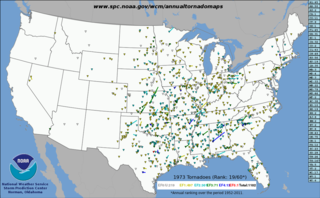
This page documents notable tornadoes and tornado outbreaks worldwide in 1973, but mostly features events in the United States. According to tornado researcher Thomas P. Grazulis, documentation of tornadoes outside the United States was historically less exhaustive, owing to the lack of monitors in many nations and, in some cases, to internal political controls on public information. Most countries only recorded tornadoes that produced severe damage or loss of life. Consequently, available documentation in 1973 mainly covered the United States. On average, most recorded tornadoes, including the vast majority of significant—F2 or stronger—tornadoes, form in the U.S., although as many as 500 may take place internationally. Some locations, like Bangladesh, are as prone to violent tornadoes as the U.S., meaning F4 or greater events on the Fujita scale.
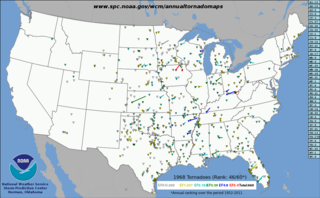
This page documents the tornadoes and tornado outbreaks of 1968, primarily in the United States. Most tornadoes form in the U.S., although some events may take place internationally. Tornado statistics for older years like this often appear significantly lower than modern years due to fewer reports or confirmed tornadoes. Two F5 tornadoes struck Iowa in the Charles City and Maynard areas, combined they claimed 18 lives and this was one of very few cases in history where two F5 or EF5 tornadoes hit the same state, on the same day.

This page documents the tornadoes and tornado outbreaks of 1964, primarily in the United States. Most tornadoes form in the U.S., although some events may take place internationally. Tornado statistics for older years like this often appear significantly lower than modern years due to fewer reports or confirmed tornadoes.

This page documents the tornadoes and tornado outbreaks of 1949, primarily in the United States. Most recorded tornadoes form in the U.S., although some events may take place internationally. Tornado statistics for older years like this often appear significantly lower than modern years due to fewer reports or confirmed tornadoes.

This page documents the tornadoes and tornado outbreaks of 1947, primarily in the United States. Most recorded tornadoes form in the U.S., although some events may take place internationally. Tornado statistics for older years like this often appear significantly lower than modern years due to fewer reports or confirmed tornadoes.













